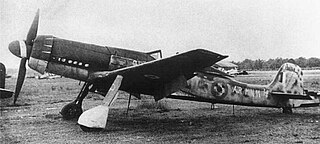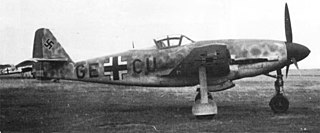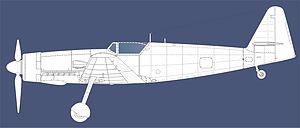
The Messerschmitt Me 210 was a German heavy fighter and ground-attack aircraft of World War II. Design started before the war, as a replacement for the Bf 110. The first examples were ready in 1939, but they proved to have unacceptably poor flight characteristics due to serious wing planform and fuselage design flaws. A large-scale operational testing program throughout 1941 and early 1942 did not cure the type's problems. The design entered limited service in 1942, but was soon replaced by the Messerschmitt Me 410 Hornisse, a further development of the Me 210. The failure of the Me 210's development program meant the Luftwaffe was forced to continue operating the Bf 110 after it had become outdated, despite mounting losses.

The Blohm & Voss BV 155 is a German high-altitude interceptor aircraft intended to be used by the Luftwaffe against raids by USAAF Boeing B-29 Superfortresses. Work started on the design as the Messerschmitt Me 155 in 1942, but the project went through a protracted development period and change of ownership, and prototypes were still under test and development when World War II ended.

The Messerschmitt Bf 109 is a German World War II fighter aircraft that was, along with the Focke-Wulf Fw 190, the backbone of the Luftwaffe's fighter force. The Bf 109 first saw operational service in 1937 during the Spanish Civil War. It was still in service at the end of World War II in 1945. It was one of the most advanced fighters when it first appeared, with an all-metal monocoque construction, a closed canopy, and retractable landing gear. A liquid-cooled, inverted-V12 aero engine powered it. It was called the Me 109 by Allied aircrew and some German aces, even though this was not the official German designation.

The Messerschmitt Bf 110, often known unofficially as the Me 110, is a twin-engined Zerstörer, fighter-bomber, and night fighter (Nachtjäger) designed by the German aircraft company Bayerische Flugzeugwerke (BFW) and produced by successor company Messerschmitt. It was primarily operated by the Luftwaffe and was active throughout the Second World War.

The Focke-Wulf Fw 187 Falke ("Falcon") was a German aircraft designed in 1935. It was conceived by Kurt Tank as a twin-engine, high-performance fighter, but the Luftwaffe saw no role for the design, perceiving it as intermediate between the Messerschmitt Bf 109 and Bf 110. Later prototypes were adapted to two-seats to compete with the Bf 110 in the heavy fighter (Zerstörer) role, but only nine aircraft were built in total.

The Avia S-199 is a propeller-driven Messerschmitt Bf 109G-based fighter aircraft built after World War II using the Bf 109G airframe and a Junkers Jumo 211F engine in place of the original and unavailable Daimler-Benz DB 605 engine. It is notable as the first fighter obtained by the Israeli Air Force, and used during the 1948 Arab-Israeli War.

The Arado Ar 240 was a German twin-engine, multi-role heavy fighter aircraft, developed for the Luftwaffe during World War II by Arado Flugzeugwerke. Its first flight was on 10 May 1940, but problems with the design hampered development, and it remained only marginally stable throughout the prototype phase. The project was eventually cancelled, with the existing airframes used for a variety of test purposes.

The Messerschmitt Me 264 was a long-range strategic bomber developed during World War II for the German Luftwaffe as its main strategic bomber. The design was later selected as Messerschmitt's competitor in the Reichsluftfahrtministerium's Amerikabomber programme, for a strategic bomber capable of attacking New York City from bases in France or the Azores.

The Focke-Wulf Ta 152 is a German high-altitude fighter–interceptor designed by Kurt Tank and produced by Focke-Wulf. It entered production too late and in insufficient numbers to have a significant role in the Second World War.

The Daimler-Benz DB 601 was a German aircraft engine that was built during World War II. It was a liquid-cooled inverted V12, and powered the Messerschmitt Bf 109, Messerschmitt Bf 110, and many others. Approximately 19,000 601s were produced before it was replaced by the improved Daimler-Benz DB 605 in 1942.

The Focke-Wulf Fw 191 was a prototype German bomber of World War II, as the Focke-Wulf firm's entry for the Bomber B advanced medium bomber design competition. Two versions were intended to be produced, a twin-engine version using the Junkers Jumo 222 engine and a four-engine variant which was to have used the smaller Daimler-Benz DB 605 engine. The project was eventually abandoned due to technical difficulties with the engines.

The Messerschmitt Me 309 was a prototype German fighter, designed in the early years of World War II to replace the Messerschmitt Bf 109. Although it had many advanced features, the Me 309's performance left much to be desired and it had so many problems that the project was cancelled with only four prototypes built. The Me 309 was one of two failed Messerschmitt projects intended to replace the Bf 109, the other being the 1943 Me 209 project.

The Junkers Jumo 213 was a World War II-era V-12 liquid-cooled aircraft engine, a development of Junkers Motoren's earlier design, the Jumo 211. The design added two features, a pressurized cooling system that required considerably less cooling fluid which allowed the engine to be built smaller and lighter, and a number of improvements that allowed it to run at higher RPM. These changes boosted power by over 500 hp and made the 213 one of the most sought-after Axis engine designs in the late-war era.

The Jumo 210 was Junkers' first production inverted V12 gasoline aircraft engine, first produced in the early 1930s. Depending on the version it produced between 610 and 730 PS and can be considered a counterpart of the Rolls-Royce Kestrel in many ways. Although originally intended to be used in almost all pre-war designs, rapid progress in aircraft design quickly relegated it to the small end of the power scale by the late 1930s. Almost all aircraft designs switched to the much larger Daimler-Benz DB 600, so the 210 was produced only for a short time before Junkers responded with a larger engine of their own, the Junkers Jumo 211.

The Daimler-Benz DB 600 was a German aircraft engine designed and built before World War II as part of a new generation of German engine technology. It was a liquid-cooled inverted V12 engine, and powered the Messerschmitt Bf 110 and Heinkel He 111 among others.
The Focke-Wulf Ta 153 (GH+KV) was a prototype German fighter aircraft built during World War II. It was a development of the Fw 190C, a Fw 190A with a DB 603A engine.

The Daimler-Benz DB 603 was a German aircraft engine used during World War II. It was a liquid-cooled 12-cylinder inverted V12 enlargement of the 33.9 Liter DB 601, which was in itself a development of the DB 600. Production of the DB 603 commenced in May 1942, and with a 44.5 liter displacement, was the largest displacement inverted V12 aircraft engine to be used in front line aircraft of the Third Reich during World War II.
The Focke-Wulf Fw 300 was a proposed very-long-range civil airliner, transport, reconnaissance aircraft and anti-ship aircraft, designed by Focke-Wulf in 1941 and 1942. The design was intended to replace the Focke-Wulf Fw 200 Condor.
The Focke Wulf Fw 159 was an experimental German fighter of the 1930s, designed by Kurt Tank which never reached production, as it was considered inferior to the He 112 and Bf 109. It was a heavier variant of the Focke-Wulf Fw 56, with several improvements, such as a retractable landing gear and enclosed cockpit.

Due to the Messerschmitt Bf 109's versatility and time in service with the German and foreign air forces, numerous variants were produced in Germany to serve for over eight years with the Luftwaffe. Additional variants were produced abroad totalling in 34,852 Bf 109s built.


















